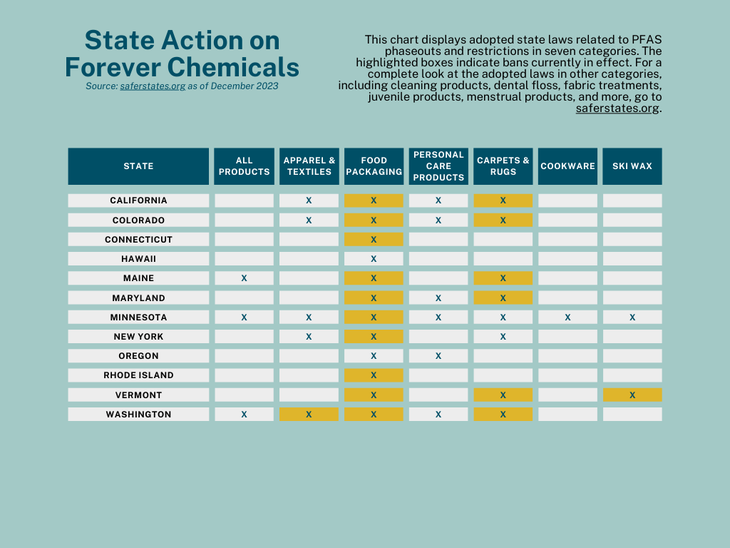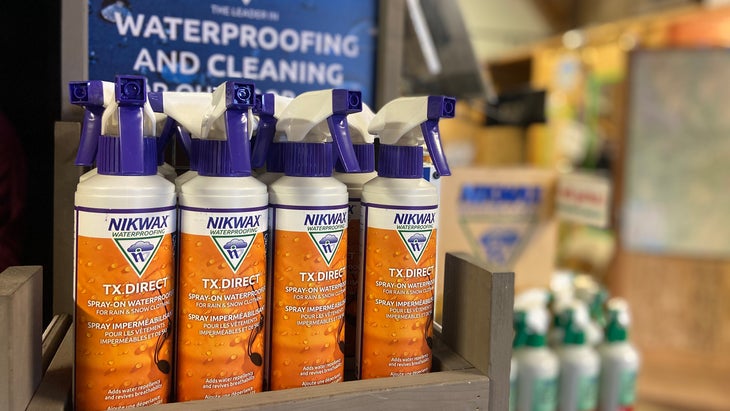Last week I spent six hours skiing in the Vermont rain, and it actually didn’t suck–largely because I was swaddled in invisible toxic chemicals, known as PFAS or “forever chemicals.” I’m speaking of the key ingredient found on and in nearly every piece of outerwear with any kind of water repellency: the chemicals that keep us dry through any weather.
But PFAS are not just in our Gore-Tex shells. They’re in countless consumer products, providing heat, oil, stain, and grease resistance. These chemicals are hugely effective–and they also pose serious human health concerns. So much so that a flood of new bans are coming across the country in a wide range of categories.
In 2024, 35 states will introduce policies banning forever chemicals, says Safer States, a national alliance of environmental health organizations and coalitions. Many are already in effect for categories like food packaging, carpets, and ski wax, which have been outlined by state in the chart below. These looming bans have sent industries around the world scrambling to find alternative solutions. It also means that we will soon have to adjust our expectations on how we need to care for things like rain jackets, if we want them to perform, says sustainability consultant Ammi Borenstein, founder of Snaplinc Consulting, an agency specializing in sustainability strategy and management.
What Are Forever Chemicals?
PFAS stands for per- and polyfluoroalkyl substances. It’s a mouthful, which is why PFAS are colloquially called “forever chemicals.” The nickname refers to the fact that these tenacious chemicals survive essentially forever. They won’t break down in the environment for a thousand years or more, which is precisely why they’re so effective at what they do: at creating a leak-proof barrier against all things liquidy.

PFAS, a family of more than 13,000 unique chemicals, were invented in the 1930s by DuPont de Nemours, Inc., as the company was working to develop a non-stick frying pan. The world soon discovered the magic of these forever chemicals. Their Herculean bonding power means that they can render humble fabrics impenetrable to weather. They prevent red wine from staining your sofa and puppy poop from ruining your carpet. They keep grease from seeping through paper plates and take-out containers. They make mascara waterproof and are found in things like butter wrappers, lotions and sunscreens, toilet paper (including certain bamboo options), and menstrual products. PFAS are on your iPhone touch screen, and have been found in both tap and well water. A recent USGS report estimates that an alarming 45 percent of our country’s tap water contains PFAS.
Forever chemicals are basically everywhere and many Americans interact with them intimately on a daily basis. So it should come as no surprise that, according to data compiled by The Center for Disease Control and Prevention, the damn things are also floating inside the veins of every one of us.
So, just how freaked out should we be?
Why Are Forever Chemicals Dangerous?
Studies have linked PFAS exposure to a host of serious health problems: a 2023 study published in eBioMedicine found associations between PFAS exposure and thyroid cancer, and several other studies have linked exposure to kidney cancer as well.
Two of the most notorious forever chemicals are PFOA and PFOS, which have historically been used in nonstick cookware, firefighting foam, and many waterproof textiles. Both have been deemed hazardous by the EPA and were phased out of manufacturing in the U.S. in the mid 2000s. But thousands of other PFAS are still in production, and we are only now starting to understand where they show up. Which, at the risk of being redundant, is everywhere.
PFAS exposure from everyday items varies significantly. “If we’re talking about eating food off paper plates that contain PFAS, for instance, your exposure risks are pretty high because PFAS can absorb into food from plates,” says Borenstein, who points to a 2022 study published on Science Direct.
But what about wearing a jacket?
Dr. Stuart Harrad, professor of environmental chemistry at University of Birmingham in the U.K., studies PFAS exposure through skin. In a 2023 study (Environmental Research) he and his collaborators found that “PFAS can indeed transfer from environmental media (like indoor dust) into skin fluids (like sweat and oils) and become available for absorption through the skin into the bloodstream.”
“I would be concerned about the potential dermal exposure if PFAS in clothing comes in direct contact with the skin,” he told me. “However, as we don’t know what PFAS are present in such clothing, we cannot say with any certainty what the health effects might be and whether these might occur at the dermal exposure levels that might arise from wearing such clothing.”
In other words, PFAS in your yoga pants or long johns—or any fabric that directly touches your skin—could absorb directly into your bloodstream. But Harrad sees less of an exposure risk with clothing that is not next-to-skin, like jackets. He says that because of the unknowns, as well as the environmental implications of creating waste, he is “loathe to advise people to throw away existing wearable items” but contends that PFAS use in “any new products should be prohibited.”
We do know, however, that forever chemicals have profound impacts on the people who work in and live near the factories that make and handle them in their raw, unfinished state. Take, for instance the community of Parkersburg, West Virginia, where the DuPont factory (now called Chemours) first created PFOA and remains one of the area’s largest employers.
In the C8 Project, one of the largest human health studies ever done, with nearly 70,000 participants in the area surrounding the plant, researchers found that PFOA was associated with six diseases: kidney cancer, testicular cancer, thyroid disease, high cholesterol, pre-eclampsia, and ulcerative colitis. While the chemical companies make obscene amounts of money, factory workers throughout the supply chain touch and inhale PFAS every day and thousands of families living downstream from the facilities drink contaminated water and breathe poisonous air.
After a decades-long quest for justice (chronicled in the excellent 2019 film Dark Waters), attorney Robert Bilott won a $670 million settlement against DuPont for more than 3,500 personal injury cases.
Widespread PFAS Bans Are Coming Soon
While PFAS are not yet regulated at a federal level, state lawmakers across the country have put them in their crosshairs. “States are transforming the marketplace by adopting policies that mandate the phase out of dangerous forever chemicals in products,” says Sarah Doll, national director of Safer States.
Starting in 2025, California will forbid the sale of most textiles with PFAS; New York will restrict them in apparel; and Colorado will ban them in upholstered furniture and ski wax. Similar laws are pending or approved in many other states.

Outdoor Brands at the Forefront of the PFAS-Free Movement
Much of the outdoor industry has been seeking safe alternatives to PFAS for years, as we reported on back in 2015, but it’s been a long process. Early iterations of PFAS-free outerwear were plagued by lackluster performance. But the brands who stayed the course have now landed on new chemistries that they claim perform well, such as footwear maker, KEEN, which has been PFAS-free since 2018. “PFAS are over-engineered for recreating outside,” contends Kirsten Blackburn, director of KEEN Effect, the company’s sustainability and impact team.
But there is a caveat: everyone agrees that PFAS-free outdoor gear will require more regular care and maintenance to keep it performing at its best.
“With diligent aftercare like washing and re-treating, these alternatives do not compromise on performance,” says Corey Simpson, Patagonia’s communications manager. Patagonia, which started tackling the complex PFAS problem in 2006, has already eliminated PFAS from its fabrics, laminates, and coatings, and by 2025 all apparel (including zippers, buttons, patches, and threads) will be completely PFAS-free. “During our research and development of these alternatives we found that the cleaner these fabrics are, the better the PFAS-free alternatives perform. So, easy-peasy, just wash and dry your gear more frequently.”
Fjällräven did away with PFAS in all its textiles back in 2015. “The important question consumers need to ask, is what level of water repellency does one need?” says Kaytlin Moeller, regional sustainability director at Fenix Outdoor, parent company to Fjällräven. “We know that DWR with PFAS provides better waterproofing on gear than DWR made without PFAS, but is waterproof really necessary for the intended use? Actions like proper garment care, following washing guidelines, and using alternative waterproofing, like waxing when the fabric allows, can provide the necessary level of water repellency without introducing hazardous chemicals into the environment.”
Care and Maintenance of PFAS-Free Outdoor Gear
For those of us who have come to expect our rain gear to keep us dry year after year with no maintenance, this new PFAS-free reality might be a hard pill to swallow. But Hannah North, manager of Gear Fix, a Bend, Oregon retailer specializing in repairing and consigning outdoor gear, says that the only place you’ll feel the difference is in the laundry room. PFAS-free outerwear will require more hands-on care, she says, but if treated properly, most people won’t notice a performance difference.

“Most people don’t wash their outerwear enough, period,” says North. “And with these new PFAS-free chemistries, it will become even more important. We tell customers to wash their outerwear, regardless of whether it has PFAS or not, after every three to five significant uses and to re-waterproof every three to five washes.” (A “significant use” is roughly a full day of use outdoors.) It’s an easy, at-home process.
“We recommend Nikwax products, which are water-based, PFAS-free, and very effective for re-waterproofing,” says North. “Waterproof clothing should never be washed with normal detergent, which will leave a residue on the fabric that hinders water repellency.”
How to Avoid Forever Chemicals in Everyday Life
While it’s almost impossible to avoid PFAS altogether, there are some concrete steps you can take to minimize your exposure to them.
- Be skeptical when you see “PFOA-free” on something like a nonstick pan. It probably means that they just use a different kind of PFAS. Remember that PFAS is a massive family of chemicals. PFOA (Perfluorooctanoic acid) is just one specific chemical in this family. Instead look for “PFAS-free” or “certified nontoxic.”
- Ditch old Teflon cookware. Opt for ceramic instead.
- Avoid fast food. The packaging wrapping that Big Mac is full of PFAS rubbing up against—and contaminating—your food. Same with microwave popcorn and paper plates. When you do get takeout, transfer it out of the container as soon as possible because heat and time increase the likelihood of food absorption.
- Store leftovers in glass containers, not plastic, which can also leach PFAS into your food.
- Avoid bottled water which can contain PFAS and nanoplastics. Opt for filtered tap water instead.
- Check your dental floss. This 2022 investigation by Mamavation, a consumer health and wellness watchdog website, found that floss products have the “highest levels of organic fluorine we have ever seen in any consumer study.” (Organic fluorine is a chemical marker for the PFAS family of chemicals.) In the lab tests, 33 percent of the tested flosses (ranging from slippery filament and waxed versions to silk and bamboo ones) came back positive for the PFAS marker.
Most importantly, take heart. The omnipresence of PFAS can make the problem feel overwhelming. But researchers are learning more each day, the media is investigating, big brands across industries are shifting away from forever chemicals, and governments are starting to act.
“A few years ago we were looking at a massive, never-ending flow of these chemicals,” Borenstein says. “Now outdoor brands, companies all over the world, and importantly, lawmakers have woken up to their harmful effects. The widespread bans will start to turn off the tap. Then we’ll need to look at mitigation of the PFAS that already exist and reducing the toxic load on our bodies and in our environment.”
In fact, the Environmental Protection Agency (EPA) just recently accelerated its work around PFAS. It is investing in new research, and now requires companies to disclose the presence of certain chemicals in products. It is also developing new methods to measure PFAS in the environment and policies to hold polluters accountable. “State policy, increased engagement from the EPA, increased consumer awareness, effective PFAS free advocates—all of these things suggest we could see national legislation banning PFAS in the near future,” says Blackburn.
To that, I say: Bring it on.

Doing right by the planet can make you happier, healthier, and—yes—wealthier. Outside’s head of sustainability, Kristin Hostetter, explores small lifestyle tweaks that can make a big impact. Write to her at climateneutral-ish@outsideinc.com.

